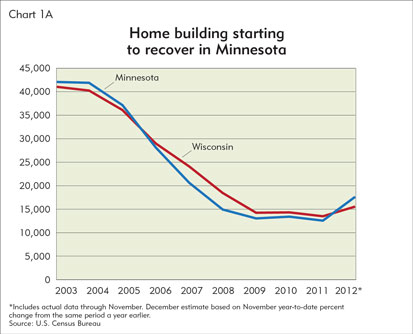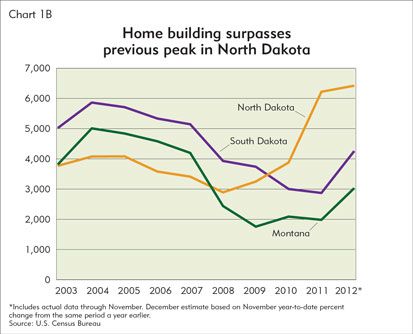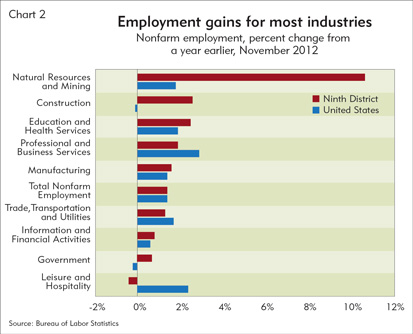Results from the Minneapolis Fed’s forecasting models and economic outlook surveys point to steady growth in 2013, with strong growth expected in North Dakota due to oil-drilling activity.
The housing sector is showing signs of recovery and, despite drought in some areas, the agriculture sector remains in good shape. However, concerns remain over government fiscal issues, a recent manufacturing slowdown and global economic conditions. Personal income and employment are expected to grow in 2013.
Cautious optimism
Respondents to the business outlook poll are optimistic overall, but more pessimistic than respondents a year earlier. District business leaders are cautious about economic conditions in the nation and in their respective states, but are more optimistic about prospects for their own businesses.
One place for renewed optimism is the housing sector, where sales and building are bouncing back. According to the Minnesota Realtors Association, closed sales in Minnesota increased 13 percent in November from a year earlier. In Sioux Falls, S.D., November closed sales were up almost 20 percent.
Stronger sales have contributed to lower inventories and higher prices. In third quarter 2012, prices in the Minneapolis-St. Paul metropolitan area increased 13 percent from a year earlier; in Sioux Falls, S.D., and Fargo, N.D., prices increased 5 percent and 4 percent, respectively.
Construction crews had more homes to build in 2012. Through November, housing units authorized were up across all district states. However, other than in North Dakota, housing units authorized totals are still far off their peak levels (see Chart 1 below). According to results of the business outlook poll, overall housing starts are expected to increase during 2013. The Minneapolis Fed’s forecasting models are mixed regarding the 2013 housing outlook.
A holiday hiccup in consumer spending?
During 2012, consumer spending showed moderate gains; however, initial measures indicate that holiday shopping was relatively mild nationally. Regionally, district retailers were cautiously optimistic for the holiday season. For example, according to the University of St. Thomas Holiday Spending Sentiment Survey, households in the Minneapolis-St. Paul area were expected to spend 10 percent more on holiday gifts than a year earlier. According to retail business contacts in the district, holiday sales in the region were probably somewhat stronger than in the nation.
There are signs that households are moving toward a better position to spend. Household balance sheets have generally improved during the past few years as many have paid down debt. Combined with recently increased home values, the debt pay-down has given households relatively more wealth.
Furthermore, consumers continue to face relatively stable prices. The consumer price index in November was up 1.8 percent compared with a year earlier. Home heating costs remained in check, as natural gas prices were relatively low during the early part of the winter. Minnesota gasoline prices in December were about the same as a year earlier. The core rate of inflation, which excludes energy and food prices, was up 1.9 percent from a year ago.
One area where consumer spending has been consistently strong is vehicle sales. Throughout 2012, district auto dealers have enjoyed substantial gains in sales. For example, during the first 10 months of 2012, registrations for new cars and light trucks increased 31 percent in Minnesota compared with a year earlier. Registrations were up 13 percent nationally.
The Minneapolis Fed’s forecasting models suggest that personal income will grow in 2013, which will help support consumer spending. According to the business outlook poll, 30 percent of respondents expect increased consumer spending in their communities, while 25 percent expect decreases.
Employment expected to grow moderately
Employment in district states during November grew 1.4 percent from a year earlier, the same as in the nation (see Chart 2). Natural resources and mining posted the strongest growth (+10.7 percent), followed by construction (+2.6 percent) and education and health services (+2.5 percent). Leisure and hospitality was the only sector with year-over-year employment losses (-.4 percent).
Gains in natural resources and mining were supported by continued expansion of oil drilling in western North Dakota and eastern Montana, the location of the Bakken oilfield. In September, 21.4 million barrels of oil were produced there, up from 13.2 million a year earlier, and accounted for 11 percent of U.S. oil output.
The number of active drilling operations in North Dakota decreased somewhat in recent months as oil companies cut costs and increased efficiency after drilling a number of initial producing wells to meet leasing requirements. While employment continues to grow rapidly in the area, the brisk pace of growth has eased somewhat as evidenced by a leveling in the number of online job postings in the North Dakota portion of the Bakken. Meanwhile, drilling in Montana has picked up recently as oil companies have expanded exploration in the western part of the Bakken.
Growth in construction employment was supported by increases in home building. Employment gains in education and health services continue in a sector that has consistently posted increases over the past few years.
According to the Minneapolis Fed’s forecasting models, nonfarm employment will grow moderately in 2013, with stronger growth expected in North Dakota and Minnesota. Employment growth in the Upper Peninsula of Michigan will remain sluggish. Unemployment rates are predicted to drop in all areas. The unemployment rate in North Dakota is expected to drop to 2.8 percent.
Despite employment gains, respondents to the business outlook poll indicated that securing workers will be challenging, but a bit less so than a year earlier. In the recent survey, 39 percent expect securing workers to be a challenge or serious challenge in 2013, down slightly from 41 percent in the prior survey.
Respondents to the business outlook poll expect modest employment gains in their communities during 2013 and somewhat stronger increases in employment at their own businesses. Respondents to the manufacturing survey expect level employment for their state economies and moderate gains at their own companies.
Signs of caution
Despite the overall positive tenor of the forecast, several risks are causing district businesses to remain cautious. Respondents were concerned about fiscal cliff negotiations and other budget issues. Business leaders seem to be looking for a clearer picture of what to expect for tax and spending policy before making some decisions on capital expenditure and hiring plans. With the fiscal cliff deal reached on Jan. 1, some concerns will be alleviated.
Concern was also expressed over a slowdown in manufacturing, which has been a key component of the recovery. According to a survey of purchasing managers by Creighton University (Omaha, Neb.), manufacturing activity in Minnesota and South Dakota decreased for five straight months before posting a gain in December, while manufacturing in North Dakota posted relatively strong growth throughout 2012.
One drag on the manufacturing sector is slowing growth in exports due in part to economic malaise among several trading partners. Through October 2012, manufactured exports among five district states (not including Michigan) increased 5 percent compared with a year ago, down from 11 percent growth for the full year of 2011. Manufactured export growth ranged from a high of 25 percent in North Dakota to a 4 percent decrease in Montana.
District manufactured exports to Europe, where struggles continue with government debt and other fiscal issues, decreased 3 percent through October 2012. Manufactured exports to China were flat during this period. District manufactured exports to China have typically posted strong growth rates, including 13 percent in 2011 and 35 percent in 2010. While China’s economy continues to grow, its growth rate has dropped recently, which has dampened demand for district exports.
Despite the recent slowing in the district manufacturing sector, year-over-year employment levels are up, and respondents to the manufacturing survey are relatively upbeat for their companies’ orders, production and employment levels in 2013.
Agriculture remains strong despite drought
From early in the growing season, many agricultural producers were concerned about how 2012 would turn out. In contrast to 2011, a year marked by substantial flooding around the district, 2012 was a year of drought. Fortunately, much of the Ninth District was spared the worst of the dryness, and low production elsewhere put upward pressure on prices, boosting farm incomes. Livestock and dairy producers haven’t fared as well, however, as higher feed costs squeezed margins. The outlook for both crop and animal product prices remains strong in 2013.
In 2012, farmers and ranchers saw big increases in prices for their products from their already strong 2011 levels (see table below). And in contrast to many agricultural states, the district saw production increases from 2011 for most crops, including corn (+5 percent), soybeans (+7 percent), wheat (+28 percent) and sugar beets (+32 percent). Dramatic production increases for sugar beets and for wheat and other small grains largely reflect a return to normal, since 2011 production was set back by flooding. While prices for several farm inputs, including fertilizer and chemicals, increased during 2012, these prices were offset by gains in crop prices.
| Crop, meat and dairy prices expected to increase in 2013 Average farm prices |
||||
|---|---|---|---|---|
| 2009/ 2010 |
2010/ 2011 |
Estimated 2011/2012 | Projected 2012/2013 | |
| (Current $ per bushel) | ||||
| Corn |
3.55
|
5.18
|
6.22
|
6.80-8.00
|
| Soybeans |
9.59
|
11.3
|
12.5
|
13.55-15.55
|
| Wheat |
4.87
|
5.7
|
7.24
|
7.70-8.30
|
2010 |
2011 |
Estimated 2012
|
Projected
2013 |
|
| (Current $ per cwt) | ||||
| All Milk |
16.29
|
20.14
|
18.50-18.60
|
19.15-19.95
|
| Steers |
95.38
|
114.73
|
122.85
|
124-134
|
| Hogs |
55.06
|
66.11
|
61.1
|
63-67
|
|
Source: |
||||
According to the Minneapolis Fed’s third-quarter (October 2012) agricultural credit conditions survey, 2012 was a strong year for agricultural income, with 95 percent of respondents reporting increased or steady income following several quarters of increases. Household spending and capital investment increased similarly. Agricultural lenders are somewhat optimistic about farm profits in the final quarter of 2012, with 60 percent expecting increased income and only 6 percent expecting decreased income.
Animal producers enjoyed continued strong prices (see table). After 2011’s large increases, prices retreated slightly for hogs and milk (both down 8 percent), while cattle prices continued to rise (7 percent increase). These prices weren’t enough to offset higher feed costs faced by meat and dairy producers.
Again, the outlook for 2013 is upbeat, as agricultural producers invest their profits. In addition to positive returns on investment, output prices are expected to rise. According to U.S. Department of Agriculture forecasts, 2013 prices for corn, soybeans, wheat, cattle, hogs and dairy are expected to increase. However, this outlook depends on whether the 2012 drought persists or fades into memory.
Joe Mahon is a Minneapolis Fed regional outreach director. Joe’s primary responsibilities involve tracking several sectors of the Ninth District economy, including agriculture, manufacturing, energy, and mining.









